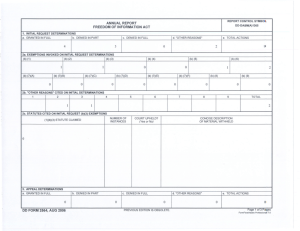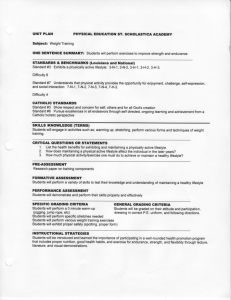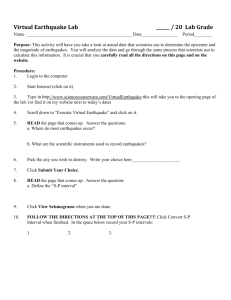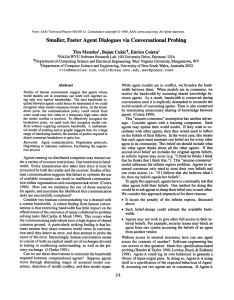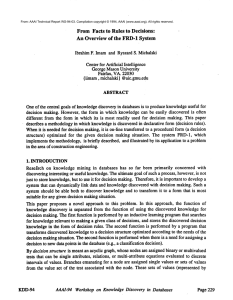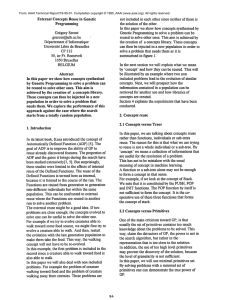J. Appl. Prob. 32, 554-557 (1995) Printed in Israel
advertisement
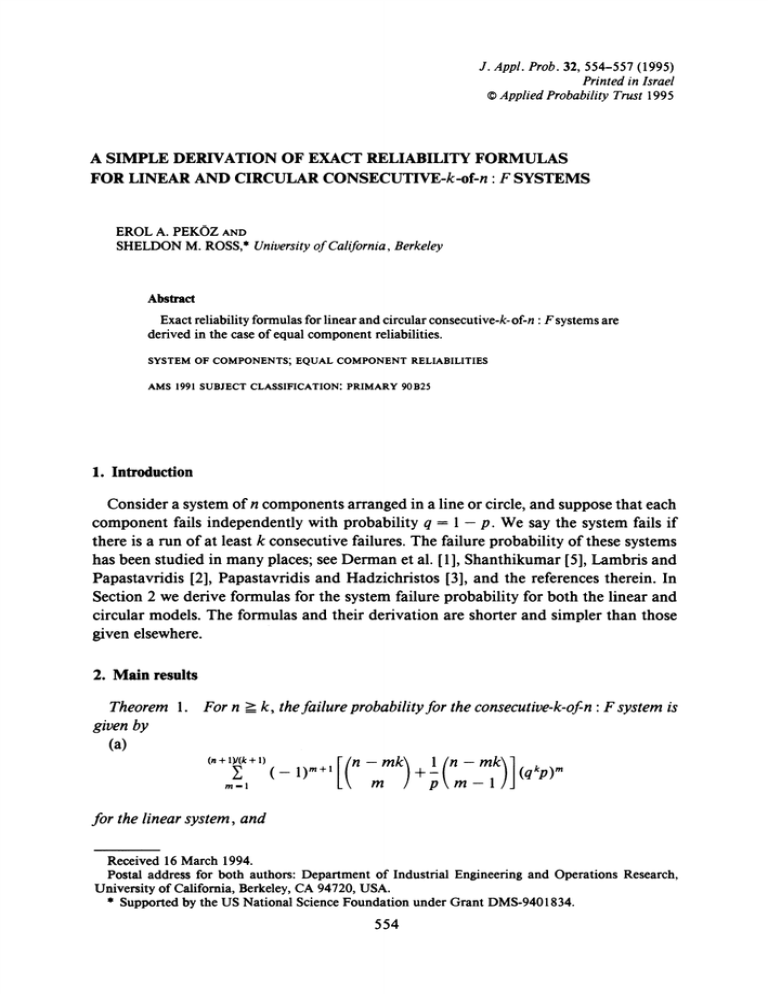
J. Appl. Prob. 32, 554-557 (1995)
Printedin Israel
? AppliedProbabilityTrust 1995
A SIMPLE DERIVATION OF EXACT RELIABILITY FORMULAS
FOR LINEAR AND CIRCULAR CONSECUTIVE-k-of-n: F SYSTEMS
EROLA. PEKOZAND
SHELDONM. ROSS,* Universityof California,Berkeley
Abstract
Exactreliabilityformulasfor linearand circularconsecutive-k-of-n: Fsystems are
derived in the case of equal component reliabilities.
SYSTEM OF COMPONENTS;EQUAL COMPONENT RELIABILITIES
AMS 1991 SUBJECT CLASSIFICATION:PRIMARY 90B25
1. Introduction
Consider a system of n components arrangedin a line or circle, and suppose that each
component fails independently with probability q = 1 - p. We say the system fails if
there is a run of at least k consecutive failures. The failure probability of these systems
has been studied in many places; see Derman et al. [1], Shanthikumar [5], Lambris and
Papastavridis [2], Papastavridis and Hadzichristos [3], and the references therein. In
Section 2 we derive formulas for the system failure probability for both the linear and
circular models. The formulas and their derivation are shorter and simpler than those
given elsewhere.
2. Main results
Theorem 1. For n > k, the failure probabilityfor the consecutive-k-of-n:F system is
given by
(a)
(n +
l)(k
E
m-I
1)
+
(--ir
+'[(n-mk)
m
(n-mk~]
p
m-1/
J
qkp)r
for the linear system, and
Received 16 March 1994.
Postal address for both authors:Department of Industrial Engineeringand Operations Research,
University of California,Berkeley,CA 94720, USA.
* Supportedby the US National Science Foundationunder GrantDMS-9401834.
554
A simplederivation
of exactreliability
formulas
(b)
+
I
In - mk 1\-
-mk
[n/(k1)
+ln]
qn
555
(- -)m+l
m
m-i
+ k(
-1
(qkp)m
for the circularsystem, where(]) =0 for i < j, and ( ) = 1.
To provethe theoremwe need the followinglemma.
Lemma 1. For an n-componentsystem, the number of ways to choose m nonoverlappingrunsof k + 1 consecutivecomponentsis:
(a)
n - mk\
(nmk
for the linearsystem, and
(b)
(n -mk)
m
k(n
- mk - 1)
m-1
for the circularsystem.
Proofof (a). For eachrun,imaginethatthe k + 1 componentsarecompressedinto a
single 'marked'component.We then have m markedcomponentsout of a total of
n - mk components.The numberof ways to arrangethem is (n mmk).
Proofof (b). Cut the circleat an arbitrarypoint betweentwo components.Call this
point the breakpoint.Then
1. the numberof wayswhereno runcrossesthe breakpointis the sameas that for the
linear system,or (n-f ,) ways,and
2. the numberof wayswherea runcrossesthe breakpointand containsi components,
1 < i _ k, to the left of the breakpointand k + 1 - i to the right, is the same as the
numberof ways to choose m - 1 runs in a linearsystemwith n - k - 1 components.
Summingover i, the total numberof ways in this case is
n - k - -(m - )k
nnmk 1)
m1
m-1
Addingthe countsfor the two cases, (b) is obtained.
Proofof Theorem1. Foreithersystem,numberthe componentsandorderthemfrom
left to right(linearsystem)or clockwise(circularsystem)and for i = 1, ***, n definethe
followingevents:
a runof k failedcomponentsfollowedby one;
A [ workingcomponentends with componenti J
Also let
An+
Note that
{a run of k failed componentsends with componentn }.
EROLA. PEKOZAND SHELDONM. ROSS
556
n+l
{linear system fails} = U Ai
i=l
and
{circularsystemfails} =( U Ai) U {all componentsfail}.
Using inclusion-exclusionwe have
P(
i(
=
Ai)
/
(-l)m
P(Ai,Ai2 * *.Ai).
+1
m
il<i2<-
? *<im
To prove (b) note that for the circularsystem
(q kp)m
=
if none of the runsoverlap
otherwise
0
and the numberof times (qkp)m appearsin the sum is the sameas the numberof waysto
choose m non-overlappingrunsof k + 1 components,whichwas calculatedin Lemma
1(b). Addingthe probabilitythatall componentsfail and notingthatthereis spacefor at
most [n/(k + 1)] non-overlappingruns,(b) is obtained.
For the linear system, with il < i2 <
(qkp)m/p
if im < n + 1 and none of the runsoverlap
if im = n + 1 and none of the runs overlap
.0
otherwise
(q kp)m
P(Ai,Ai.
*-A) =
* < im
.
and the numberof times (qkp)m appearsin the sum is the sameas the numberof waysto
choose m non-overlappingruns of k + 1 componentsin an n-componentsystem,and
the number of times (qkp)m/p appears (the case where the last k components fail) is the
same as the number of ways to choose m - 1 of these runs in an n - k component
system.By Lemmal(a) the formeris (n -mk) and the latteris
n -k-(m
\
m-1 I
n - mk
-1)k
)
m-I
J
Combiningand noting that not more than [(n + 1)/(k+ 1)] of the events can occur
together,(a) is obtained.
Remarks
1. By lettingA, be the event that a runof k consecutivefailuresends with component
i, an expression for the system failure probability can be obtained (using inclusionexclusion), though the combinatorics become complicated due to overlapping runs.
DefiningAias in the proofof Theorem1 eliminatesthe possibilityof overlapsandgreatly
simplifiesthe derivation.
2. For the case wherethe componentsare not identical,see Pekoz and Ross [4] for a
methodof approximatingthe failureprobability.
A simplederivation
formulas
of exactreliability
557
References
G. ANDRoss S. (1982) On the consecutive-k-out-of-n:F system.
[1] DERMAN,D., LIEBERMAN,
IEEE Trans. Reliability31, 57-63.
M. ANDPAPASTAVRIDIS,
S. (1985) Exact reliabilityformulas for linear and circular
[2] LAMBRIS,
consecutive-k-of-n:F systems. IEEE Trans. Reliability34, 124-126.
S. ANDHADZICHRISTOS,
I. (1988) Formulasfor the reliabilityof a consecutive[3] PAPASTAVRIDIS,
k-out-of-n: F system. J. Appl. Prob. 25, 772-779.
[4] PEKOZ,E. ANDRoss, S. (1994) Improving Poisson approximations.Prob. Eng. Inf. Sci. 8,
449-462.
G. (1982) Recursive algorithmto evaluate the reliabilityof a consecutive-k[5] SHANTHIKUMAR,
out-of-n: F system. IEEE Trans. Reliability31, 442-443.
ROLLO DAVIDSON TRUST
The Trustees of the Rollo Davidson Trust give notice that they have awarded
Rollo Davidson Prizes for 1995 to Philippe Biane (University of Paris VI) for his
work on Brownian motion and quantum probability, and to Yuval Peres (University of California at Berkeley) for his work on probability on trees and connections
with Brownian motion.
